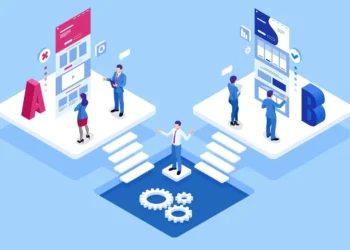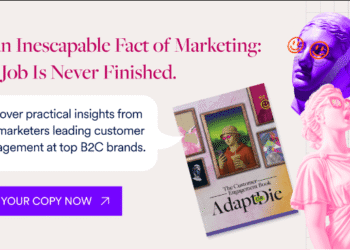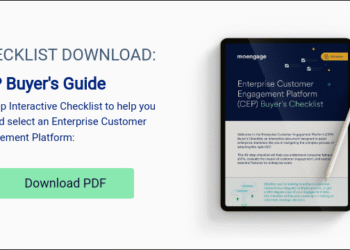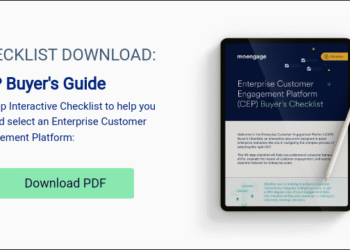Reading Time: 9 minutes
In marketing, data isn’t a buzzword. It’s the lifeblood of all successful campaigns.
But are you truly harnessing its power, or are you drowning in a sea of information? To answer this question (and many others), we sat down with Ankur Kothari, a seasoned Martech expert, to dive deep into this crucial topic.
This interview, originally conducted for Chapter 6 of “The Customer Engagement Book: Adapt or Die” explores how businesses can translate raw data into actionable insights that drive real results.
Ankur shares his wealth of knowledge on identifying valuable customer engagement data, distinguishing between signal and noise, and ultimately, shaping real-time strategies that keep companies ahead of the curve.
Ankur Kothari Q&A Interview
1. What types of customer engagement data are most valuable for making strategic business decisions?
Primarily, there are four different buckets of customer engagement data. I would begin with behavioral data, encompassing website interaction, purchase history, and other app usage patterns.
Second would be demographic information: age, location, income, and other relevant personal characteristics.
Third would be sentiment analysis, where we derive information from social media interaction, customer feedback, or other customer reviews.
Fourth would be the customer journey data.
We track touchpoints across various channels of the customers to understand the customer journey path and conversion. Combining these four primary sources helps us understand the engagement data.
2. How do you distinguish between data that is actionable versus data that is just noise?
First is keeping relevant to your business objectives, making actionable data that directly relates to your specific goals or KPIs, and then taking help from statistical significance.
Actionable data shows clear patterns or trends that are statistically valid, whereas other data consists of random fluctuations or outliers, which may not be what you are interested in.
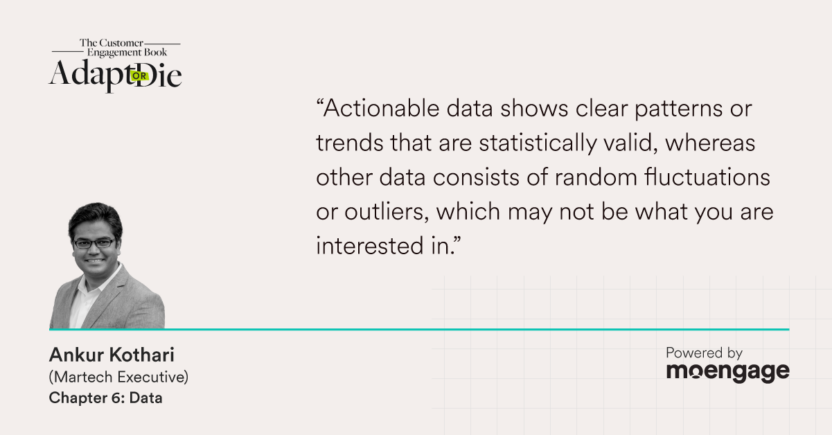
You also want to make sure that there is consistency across sources.
Actionable insights are typically corroborated by multiple data points or channels, while other data or noise can be more isolated and contradictory.
Actionable data suggests clear opportunities for improvement or decision making, whereas noise does not lead to meaningful actions or changes in strategy.
By applying these criteria, I can effectively filter out the noise and focus on data that delivers or drives valuable business decisions.
3. How can customer engagement data be used to identify and prioritize new business opportunities?
First, it helps us to uncover unmet needs.
By analyzing the customer feedback, touch points, support interactions, or usage patterns, we can identify the gaps in our current offerings or areas where customers are experiencing pain points.
Second would be identifying emerging needs.
Monitoring changes in customer behavior or preferences over time can reveal new market trends or shifts in demand, allowing my company to adapt their products or services accordingly.
Third would be segmentation analysis.
Detailed customer data analysis enables us to identify unserved or underserved segments or niche markets that may represent untapped opportunities for growth or expansion into newer areas and new geographies.
Last is to build competitive differentiation.
Engagement data can highlight where our companies outperform competitors, helping us to prioritize opportunities that leverage existing strengths and unique selling propositions.
4. Can you share an example of where data insights directly influenced a critical decision?
I will share an example from my previous organization at one of the financial services where we were very data-driven, which made a major impact on our critical decision regarding our credit card offerings.
We analyzed the customer engagement data, and we discovered that a large segment of our millennial customers were underutilizing our traditional credit cards but showed high engagement with mobile payment platforms.
That insight led us to develop and launch our first digital credit card product with enhanced mobile features and rewards tailored to the millennial spending habits. Since we had access to a lot of transactional data as well, we were able to build a financial product which met that specific segment’s needs.
That data-driven decision resulted in a 40% increase in our new credit card applications from this demographic within the first quarter of the launch. Subsequently, our market share improved in that specific segment, which was very crucial.
5. Are there any other examples of ways that you see customer engagement data being able to shape marketing strategy in real time?
When it comes to using the engagement data in real-time, we do quite a few things. In the recent past two, three years, we are using that for dynamic content personalization, adjusting the website content, email messaging, or ad creative based on real-time user behavior and preferences.
We automate campaign optimization using specific AI-driven tools to continuously analyze performance metrics and automatically reallocate the budget to top-performing channels or ad segments.
Then we also build responsive social media engagement platforms like monitoring social media sentiments and trending topics to quickly adapt the messaging and create timely and relevant content.
With one-on-one personalization, we do a lot of A/B testing as part of the overall rapid testing and market elements like subject lines, CTAs, and building various successful variants of the campaigns.
6. How are you doing the 1:1 personalization?
We have advanced CDP systems, and we are tracking each customer’s behavior in real-time. So the moment they move to different channels, we know what the context is, what the relevance is, and the recent interaction points, so we can cater the right offer.
So for example, if you looked at a certain offer on the website and you came from Google, and then the next day you walk into an in-person interaction, our agent will already know that you were looking at that offer.
That gives our customer or potential customer more one-to-one personalization instead of just segment-based or bulk interaction kind of experience.
We have a huge team of data scientists, data analysts, and AI model creators who help us to analyze big volumes of data and bring the right insights to our marketing and sales team so that they can provide the right experience to our customers.
7. What role does customer engagement data play in influencing cross-functional decisions, such as with product development, sales, and customer service?
Primarily with product development — we have different products, not just the financial products or products whichever organizations sell, but also various products like mobile apps or websites they use for transactions. So that kind of product development gets improved.
The engagement data helps our sales and marketing teams create more targeted campaigns, optimize channel selection, and refine messaging to resonate with specific customer segments.
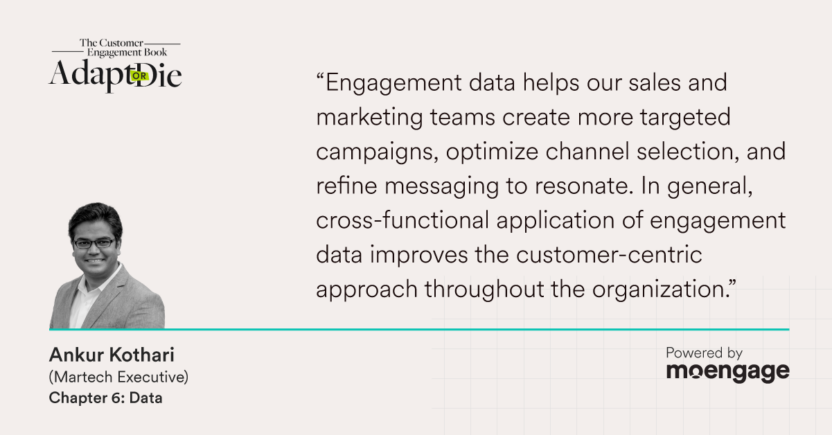
Customer service also gets helped by anticipating common issues, personalizing support interactions over the phone or email or chat, and proactively addressing potential problems, leading to improved customer satisfaction and retention.
So in general, cross-functional application of engagement improves the customer-centric approach throughout the organization.
8. What do you think some of the main challenges marketers face when trying to translate customer engagement data into actionable business insights?
I think the huge amount of data we are dealing with. As we are getting more digitally savvy and most of the customers are moving to digital channels, we are getting a lot of data, and that sheer volume of data can be overwhelming, making it very difficult to identify truly meaningful patterns and insights.
Because of the huge data overload, we create data silos in this process, so information often exists in separate systems across different departments. We are not able to build a holistic view of customer engagement.
Because of data silos and overload of data, data quality issues appear. There is inconsistency, and inaccurate data can lead to incorrect insights or poor decision-making. Quality issues could also be due to the wrong format of the data, or the data is stale and no longer relevant.
As we are growing and adding more people to help us understand customer engagement, I’ve also noticed that technical folks, especially data scientists and data analysts, lack skills to properly interpret the data or apply data insights effectively.
So there’s a lack of understanding of marketing and sales as domains.
It’s a huge effort and can take a lot of investment.
Not being able to calculate the ROI of your overall investment is a big challenge that many organizations are facing.
9. Why do you think the analysts don’t have the business acumen to properly do more than analyze the data?
If people do not have the right idea of why we are collecting this data, we collect a lot of noise, and that brings in huge volumes of data. If you cannot stop that from step one—not bringing noise into the data system—that cannot be done by just technical folks or people who do not have business knowledge.
Business people do not know everything about what data is being collected from which source and what data they need. It’s a gap between business domain knowledge, specifically marketing and sales needs, and technical folks who don’t have a lot of exposure to that side.
Similarly, marketing business people do not have much exposure to the technical side — what’s possible to do with data, how much effort it takes, what’s relevant versus not relevant, and how to prioritize which data sources will be most important.
10. Do you have any suggestions for how this can be overcome, or have you seen it in action where it has been solved before?
First, cross-functional training: training different roles to help them understand why we’re doing this and what the business goals are, giving technical people exposure to what marketing and sales teams do.
And giving business folks exposure to the technology side through training on different tools, strategies, and the roadmap of data integrations.
The second is helping teams work more collaboratively. So it’s not like the technology team works in a silo and comes back when their work is done, and then marketing and sales teams act upon it.
Now we’re making it more like one team. You work together so that you can complement each other, and we have a better strategy from day one.
11. How do you address skepticism or resistance from stakeholders when presenting data-driven recommendations?
We present clear business cases where we demonstrate how data-driven recommendations can directly align with business objectives and potential ROI.
We build compelling visualizations, easy-to-understand charts and graphs that clearly illustrate the insights and the implications for business goals.
We also do a lot of POCs and pilot projects with small-scale implementations to showcase tangible results and build confidence in the data-driven approach throughout the organization.
12. What technologies or tools have you found most effective for gathering and analyzing customer engagement data?
I’ve found that Customer Data Platforms help us unify customer data from various sources, providing a comprehensive view of customer interactions across touch points.
Having advanced analytics platforms — tools with AI and machine learning capabilities that can process large volumes of data and uncover complex patterns and insights — is a great value to us.
We always use, or many organizations use, marketing automation systems to improve marketing team productivity, helping us track and analyze customer interactions across multiple channels.
Another thing is social media listening tools, wherever your brand is mentioned or you want to measure customer sentiment over social media, or track the engagement of your campaigns across social media platforms.
Last is web analytical tools, which provide detailed insights into your website visitors’ behaviors and engagement metrics, for browser apps, small browser apps, various devices, and mobile apps.
13. How do you ensure data quality and consistency across multiple channels to make these informed decisions?
We established clear guidelines for data collection, storage, and usage across all channels to maintain consistency. Then we use data integration platforms — tools that consolidate data from various sources into a single unified view, reducing discrepancies and inconsistencies.
While we collect data from different sources, we clean the data so it becomes cleaner with every stage of processing.
We also conduct regular data audits — performing periodic checks to identify and rectify data quality issues, ensuring accuracy and reliability of information. We also deploy standardized data formats.
On top of that, we have various automated data cleansing tools, specific software to detect and correct data errors, redundancies, duplicates, and inconsistencies in data sets automatically.
14. How do you see the role of customer engagement data evolving in shaping business strategies over the next five years?
The first thing that’s been the biggest trend from the past two years is AI-driven decision making, which I think will become more prevalent, with advanced algorithms processing vast amounts of engagement data in real-time to inform strategic choices.
Somewhat related to this is predictive analytics, which will play an even larger role, enabling businesses to anticipate customer needs and market trends with more accuracy and better predictive capabilities.
We also touched upon hyper-personalization. We are all trying to strive toward more hyper-personalization at scale, which is more one-on-one personalization, as we are increasingly capturing more engagement data and have bigger systems and infrastructure to support processing those large volumes of data so we can achieve those hyper-personalization use cases.
As the world is collecting more data, privacy concerns and regulations come into play.
I believe in the next few years there will be more innovation toward how businesses can collect data ethically and what the usage practices are, leading to more transparent and consent-based engagement data strategies.
And lastly, I think about the integration of engagement data, which is always a big challenge. I believe as we’re solving those integration challenges, we are adding more and more complex data sources to the picture.
So I think there will need to be more innovation or sophistication brought into data integration strategies, which will help us take a truly customer-centric approach to strategy formulation.
This interview Q&A was hosted with Ankur Kothari, a previous Martech Executive, for Chapter 6 of The Customer Engagement Book: Adapt or Die.
Download the PDF or request a physical copy of the book here.
The post Ankur Kothari Q&A: Customer Engagement Book Interview appeared first on MoEngage.




